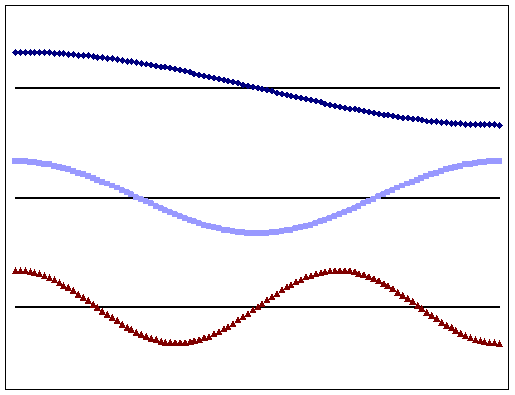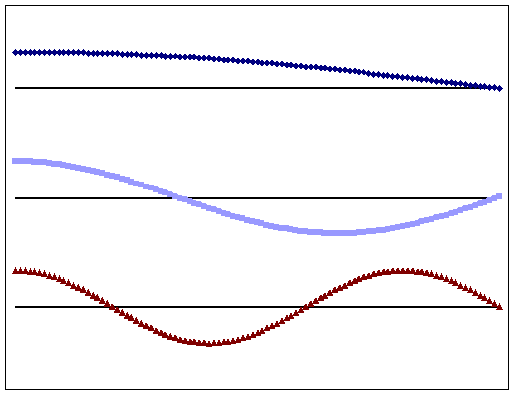Wednesday:
Sound Resonance.
We examined standing waves in sound which we tend to observe when the sound is confined
to a tube such as in an organ, flute, etc. Recall that in a standing wave the spatial
and temporal parts of the wave decouple and that the special "resonant" patterns on a string
resulted from ensuring that the spatial part sin[kx+(φ1+φ2)/2]
satisfied the "fixed" boundary conditions y(x=0,t)=0 and y(x+L,t)=0. There
are two types of boundary conditions for sound in a tube:
-
open for
which the wave should be at an antinode;
-
closed for
which the wave should be at an node.
A tube has two ends and thus there are two standard scenarios
-
open-open (with antinodes at both ends)
-
open-closed (with an antinode at one end and node at the
other)
|
Open-Open
|
Open-Closed
|

|

|
| L = ( 2 n ) λ / 4 n=1,2,...
|
L = ( 2 n - 1 ) λ / 4 n=1,2,... |
| f = ( 2 n ) v / ( 4 L ) n=1,2,... |
f = ( 2 n - 1 ) v / ( 4 L ) n=1,2,... |
In Open-Open scenario the tube's length is an even mutiple of quarter wavelengths, while in
the Open-Closed scenario the tube's length is an odd multiple of quarter wavelengths. Correspondlingly, in the Open-Open scenario the resonont frequencies
are even multiples of v/(4L), while the Open-Closed scenario the resonant frequencies
are odd multiples of v/(4L).
Doppler Effect.
Part 1. Moving Observer
Consider an observer moving toward a sound source. After the observer passes one maximum, it
is a distance λ from the next maximum and heading toward it with a speed vobserver. Meanwhile that
next maximum is heading toward the observer with a speed vsound. Using the next maximum's position when the first maximum is
detected as the origin, we can determine the time that passes before the next maximum is observed by
setting the position of the next maximum equal to the position of the observer.
xnext max = vsound t = λ - vobserver t = xobserver
t = λ / ( vsound + vobserver )
This t will be the "observed period" hence the observed frequency will be:
fobserved = [ ( vsound + vobserver ) / vsound ] foriginal
Part 1. Moving Source. Consider a sound source moving toward the observer.
The source emits a maximum which travels a speed vsound for a period T before emitting a second
maximum. The first maximum is then at vsoundT. However, the source itself has moved to
vsource T. Hence the distance between maxima, the wavelength is
λ = ( vsound - vsource ) T
The phenomenon is observed
fobserved = vsound / λ =
vsound foriginal /
( vsound - vsource )















